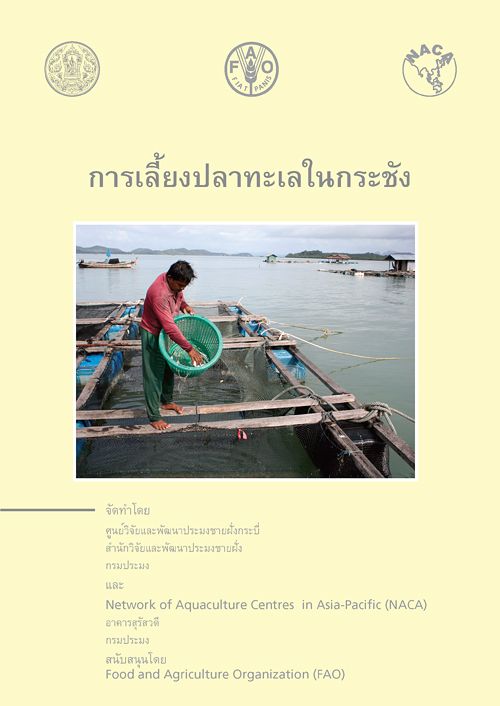การเลี้ยงปลาทะเลในกระชัง (Training manual on marine finfish cage culture)
7 July 2007 | 6350 Downloads | .pdf | 2.63 MB | Better management practices, Livelihoods, gender and social issues, Marine finfish, Thailand, Education and Training
With FAO financial support, Krabi Coastal Fisheries Research and Development Centre (Krabi CFRDC) of the Department of Fisheries, Thailand and NACA organised 10 training courses at Krabi CFRDC in 2006 to upgrade the skills and knowledge of tsunami affected farmers in marine cage aquaculture techniques. The training manual of this course is geared towards giving small-scale farmers a solid technical grounding that will enable them to improve their farm productivity and reduce losses through understanding of markets and economic factors, better farm siting. and improved feeding, handling and stock management practices. This knowledge will help the trainees and other fish farmers to improve their productivity and profitability while also reducing their risk profile. The technical contents of the training manual are as follows:
Status of grouper culture and marketing (by Mr. Paiboon Bunlipatanon):
- History of marine finfish culture in Thailand.
- Briefing on status and economically important species of cultured marine fish.
- Status on marine fish markets in Thailand and importing countries.
- Trends of export markets for marine fish.
- Future trends and problems in marine fish culture and.
- Plans for further development.
Site selection and cage maintenance (by Mrs. Ampai Longloy):
- Species of cultured marine fish including their relative advantages and disadvantages.
- Culture methods of marine finfish.
- Site selection for pond culture and cage culture in ponds.
- Site selection for cage culture.
- Cage structure, nets and relevant materials.
- Sources of fingerlings and suitable stocking density.
- Suitable water quality.
- Cage maintenance in Thailand and other countries.
Seed production and fingerling rearing (by Mr. Arkom Singhabun):
- Introduction of marine fish culture.
- Hatchery and nursery of economic species in Thailand (red spotted grouper, tiger grouper, sea bass).
- Key factors for successful breeding.
- Broodstock culture and management.
- Spawning and egg collection.
- Hatching.
- Larval rearing.
- Nursery.
- Packing and transportation of fingerlings.
Fish nutrition and fish feeding (by Mr. Samart Detsathit):
- Major problems in fish feed.
- Nutritional requirement for marine fish feed.
- Nutrient contents and raw materials for artificial feed production.
- Advantages and disadvantages of fresh feed (trash fish).
- Advantages and disadvantages of moist feed.
- Advantages & disadvantages, selection and storage of pelletised feed.
- Rates, timing and frequency of feeding,
- Factors related to fish feeding behaviour.
- Caution for fish feeding.
Common diseases of marine finfish, treatment and prevention (by Ms. Putcharee Soonsun):
- Parasites.
- Fungal diseases.
- Bacterial diseases.
- Viral diseases.
- Other causes (water quality, toxic substances, chemicals, temperature, abnormal fish, and malnutrition).
- Common practices for diagnosis.
- Chemicals and drugs used in disease treatment and prevention.
Environmental friendly aquaculture (by Ms. Onkalya Maengyoo):
- Environmental impacts of aquaculture (natural and man made).
- Environmental impacts of cage culture.
- Environmentally friendly aquaculture practices.
- GAP standards for cage culture.
ด้วยการสนับสนุนด้านการเงินจากองค์การอาหารและเกษตรแห่งสหประชาชาติ ศูนย์วิจัยและพัฒนาประมงชายฝั่งกระบี่ กรมประมงและ NACA ได้จัดการฝึก อบรมจำนวน 10 ครั้งที่ศูนย์ ฯ กระบี่ ในปี 2006 เพื่อพัฒนาฝีมือและ ความรู้ด้านเทคนิคการเลี้ยงปลากระชังทะเลให้แก่เกษตรกรผู้ประสบภัยจาก คลื่นสุนามิ คู่มือการฝึกอบรมฉบับนี้มุ่งเน้นให้เกษตรกรรายย่อยได้รับความ รู้เพิ่มเติม เพื่อให้กลับไปพัฒนาเทคนิคการเลี้ยงของตนเองให้มีผลผลิตเพิ่มขึ้น จากการคัดเลือกสถานที่เลี้ยงที่เหมาะสม การพัฒนาอาหารที่นำมาเลี้ยงปลา รวมทั้งการปล่อยลูกปลาที่เหมาะสมและการจับปลาขายนอกจากนี้ยังสามารถ ลดการศูนย์เสียจากปัญหาเรื่องตลาดและความผันแปรของเศรษฐกิจด้วย ความรู้ที่ได้จากคู่มือนี้นอกจากมีประโยชน์ต่อผู้เข้ารับการอบรม โดยตรงแล้ว ยังช่วยให้เกษตรกรอื่น ๆ ที่ได้อ่านแล้วนำความรู้ไปพัฒนาการเลี้ยงของตนเองด้วย เนื้อหาทางวิชาการในคู่มือนี้ประกอบด้วย :
สถานการณ์การเพาะเลี้ยงปลาทะเลและการตลาด (ไพบูลย์ บุญลิปตานนท์):
- ประวัติการเลี้ยงปลาทะเลในประเทศไทย.
- ชนิดของปลาทะเลที่สำคัญทางเศรษฐกิจและผลผลิต.
- การตลาดในประเทศและการส่งออก.
- ข้อควรคำนึงถึงการเลี้ยงปลาในอนาคต (ตลาดรวมถึงการส่งออก, เทคนิคการเลี้ยง, คุณภาพผลผลิต, อาหารสำเร็จรูป):
การเลือกที่ตั้งฟาร์มและการดูแลรักษา (อำไพ ล่องลอย).
- ปลาที่นิยมเลี้ยงกันโดยทั่วไปและข้อดีข้อเสีย.
- วิธีการเลี้ยงปลาโดยทั่วไป.
- การเลือกทำเลที่ตั้งฟาร์ม (บ่อดิน กระชังและกระชังในบ่อดิน):
- รูปแบบของกระชังและวัสดุที่นำมาใช้.
- แหล่งพันธุ์ปลาและอัตราการปล่อย.
- คุณภาพน้ำที่เหมาะสม.
- การดูแลรักษากระชัง (รวมทั้งต่างประเทศ).
การเพาะเลี้ยงและอนุบาลปลา (อาคม สิงหบุญ):
- คำนำเกี่ยวกับการเลี้ยงปลาทะเล.
- การเพาะและอนุบาลปลาที่มีมูลค่าทางเศรษฐกิจ.
- ปัจจัยที่สำคัญในการเพาะพันธุ์ปลาให้สำเร็จ.
- การขุนพ่อแม่พันธุ์.
- การรวบรวมไข่ปลา.
- การอนุบาลลูกปลา.
- การบรรจุและลำเลียงลูกปลา.
อาหารและการให้อาหารปลาทะเล (สามาร เดชสถิตย์):
- ปัญหาสำคัญเกี่ยวกับอาหารปลา.
- ชนิดอาหารและสารอาหารที่ปลาต้องการ.
- วัสดุอาหารและปริมาณที่ไว้ทำอาหารสำเร็จรูป.
- ข้อดีและเสียในการใชปลาสด.
- ข้อดีและเสียในการใช้อาหารผสมเปียก.
- ข้อดีและข้อเสียในการใช้อาหารเม็ดสำเร็จรูป.
- การเลือกและการเก็บรักษาอาหารเม็ดสำเร็จรูป.
- การเลือกและการเก็บรักษาอาหารเม็ด.
- เทคนิคการให้อาหารปลา (อัตราการให้ช่วงเวลาการให้และความถี่):
- ปัจจัยที่มีผลต่อการกันอาหารของปลา.
- ข้อควรระวังในการให้อาหารปลา.
การป้องกันและกำจัดโรคปลา (พัชรี ซุ่นสั้น):
- โรคจากพยาธิ.
- โรคจากแบคทีเรีย.
- โรคจากเชื้อไวรัส.
- โรคที่เกิดจากปัจจัยอื่น ๆ (คุณภาพน้ำ สารพิษ สารเคมี อุณหภูมิผิดปกติ ขาดสารอาหาร และความผิดปกติของอวัยวะปลา):
- การป้องกันและรักษารวมถึงการใช้ยาและสารเคมี.
การเพาะเลี้ยงสัตว์น้ำที่เป็นมิตรกับสิ่งแวดล้อม (วรรเพ็ญ คำมี):
- ปัญหาทางด้านสิ่งแวดล้อมต่อการเลี้ยงปลาในกระชัง.
- ผลกระทบต่อสิ่งแวดล้อมที่มาจากการเลี้ยงปลา.
- การเพาะเลี้ยงที่เป็นมิตรกับสิ่งแวดล้อม.
- มาตรฐานการปฏิบัติการทางการประมงที่ดีสำหรับการเลี้ยงปลาทะเล (GAP).
Creative Commons Attribution.

